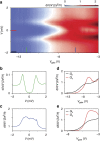Ballistic superconductivity in semiconductor nanowires
- PMID: 28681843
- PMCID: PMC5504288
- DOI: 10.1038/ncomms16025
Ballistic superconductivity in semiconductor nanowires
Erratum in
-
Author Correction: Ballistic superconductivity in semiconductor nanowires.Nat Commun. 2025 Mar 12;16(1):2459. doi: 10.1038/s41467-025-57863-x. Nat Commun. 2025. PMID: 40075088 Free PMC article. No abstract available.
Expression of concern in
-
Editorial Expression of Concern: Ballistic superconductivity in semiconductor nanowires.Nat Commun. 2025 Apr 3;16(1):3185. doi: 10.1038/s41467-025-58136-3. Nat Commun. 2025. PMID: 40180910 Free PMC article. No abstract available.
Abstract
Semiconductor nanowires have opened new research avenues in quantum transport owing to their confined geometry and electrostatic tunability. They have offered an exceptional testbed for superconductivity, leading to the realization of hybrid systems combining the macroscopic quantum properties of superconductors with the possibility to control charges down to a single electron. These advances brought semiconductor nanowires to the forefront of efforts to realize topological superconductivity and Majorana modes. A prime challenge to benefit from the topological properties of Majoranas is to reduce the disorder in hybrid nanowire devices. Here we show ballistic superconductivity in InSb semiconductor nanowires. Our structural and chemical analyses demonstrate a high-quality interface between the nanowire and a NbTiN superconductor that enables ballistic transport. This is manifested by a quantized conductance for normal carriers, a strongly enhanced conductance for Andreev-reflecting carriers, and an induced hard gap with a significantly reduced density of states. These results pave the way for disorder-free Majorana devices.
Conflict of interest statement
The authors declare no competing financial interests.
Figures




References
-
- Read N. & Green D. Paired states of fermions in two dimensions with breaking of parity and time-reversal symmetries and the fractional quantum Hall effect. Phys. Rev. B 61, 10267 (2000).
-
- Kitaev A. Y. Unpaired Majorana fermions in quantum wires. Phys. Usp. 44, 131–136 (2001).
-
- Fu L. & Kane C. L. Superconducting proximity effect and Majorana fermions at the surface of a topological insulator. Phys. Rev. Lett. 100, 096407 (2008). - PubMed
-
- Lutchyn R. M., Sau J. D. & Das Sarma S. Majorana fermions and a topological phase transition in semiconductor-superconductor heterostructures. Phys. Rev. Lett. 105, 077001 (2010). - PubMed
-
- Oreg Y., Refael G. & von Oppen F. Helical liquids and Majorana bound states in quantum wires. Phys. Rev. Lett. 105, 177002 (2010). - PubMed
Publication types
LinkOut - more resources
Full Text Sources
Other Literature Sources
Miscellaneous

